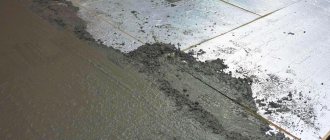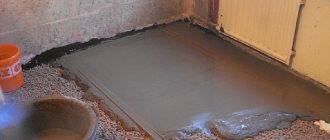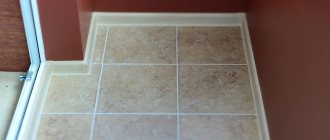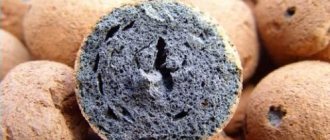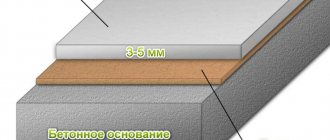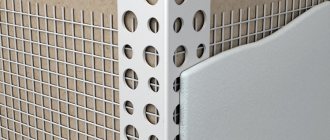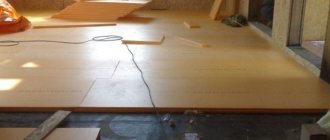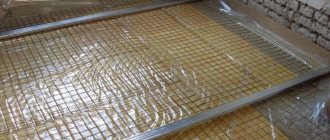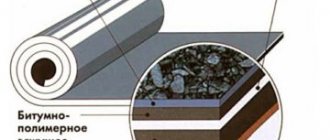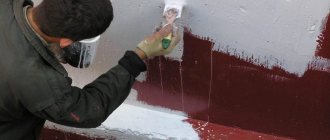Materials with low density, excellent thermal insulation characteristics and, at the same time, quite acceptable rigidity and the ability to withstand mechanical loads, open up wide possibilities for floor insulation, including even in apartments of multi-storey buildings. A typical representative of such materials is polystyrene foam. And such floor insulation with polystyrene foam under the screed is especially important on the first floors located above unheated basements or ventilated cold plinths.
Floor insulation with polystyrene foam under screed
As we will see later, you can carry out similar work yourself. The main thing is to purchase high-quality insulation material of the required thickness and strictly follow the technological recommendations for pouring the screed.
What thickness and density of polystyrene foam to choose for floor screed
The article describes in detail how to choose polystyrene foam for floor insulation.
The main focus is on density and thickness. Important advice for buyers is given. When it comes to using expanded polystyrene for insulation and arrangement of any object, issues related to its thickness and density are inevitably raised. Indeed, these are important parameters on which the durability and efficiency of the structure will depend.
How to make the right choice? Let's talk.
Adhesive for extruded polystyrene foam
Compositions for EPP are produced in several types, each of which is used for a specific type of work (for example, for work on brick, on concrete, for work in winter). If we are talking specifically about insulation, then adhesives for Penoplex (one of the brands presented on the Russian market) are divided into three groups:
- Polyurethane. Such compositions have the form of foam, so they are applied using a mounting gun.
- Bitumen. The binder (bitumen) is excellent for reliably gluing penoplex. In addition, the composition has excellent waterproofing characteristics.
- Polymer-cement. Unlike the previous type, the adhesive properties of this glue are much better. You can glue any materials to it, not just penoplex.
Extruded polystyrene foam, despite existing myths about its dangers, is a completely safe material to use, as well as its production. That's all, if you have anything to add, write to us in the comments. And at the end, a short video on how to choose the right quality insulation:
Which foam to choose for the floor
Of course, if possible it is better to do without foam.
After all, why do we need extra chemicals in the house? Outside the house is still tolerable. But it is better not to use it indoors. Chemistry after all. But if the problem of floor insulation is acute, if there is no way around it, if you have firmly decided to use polystyrene foam for these purposes, then now we will consider this issue in detail.
So, preference is often given to non-press self-extinguishing polystyrene foam - PSB-S (it has already been written about foam brands on Vyborstm.ru). This material has found its greatest application in insulating houses (walls, floors, etc.).
All that remains is to choose the desired thickness and density.
We will consider the example of a case where polystyrene foam is laid on the floor (to insulate it), and a concrete screed is placed on top. This is the most commonly used option.
In addition, it must be taken into account that the concrete screed will have very low vapor permeability, which will protect against the penetration of harmful vapors from the foam into the living space.
Material selection criteria
The insulation installed before pouring the concrete screed must meet certain requirements. It must be as resistant to moisture and microorganisms as possible. If the material does not have such stability, then the thermal insulation layer will quickly become unusable and begin to collapse, which will lead to increased heat loss and destruction of the floor structure as a whole.
Insulation is an obligatory stage in the arrangement of the floor.
The material for thermal insulation must have a low thermal conductivity. The lower the value of this indicator, the better: the more heat will remain inside the room.
Good insulation must withstand serious mechanical loads, especially for those rooms where, in addition to furniture, the floor is affected by high traffic.
When choosing thermal insulation, it is recommended to pay attention to the technical characteristics of the material, since only high-quality insulation will help create a comfortable microclimate in your home.
What foam density to choose for floor screed
Now manufacturers produce such material with a density of 15, 25, 35, 50 (kg/cubic meter).
And for the floor (in residential buildings) it is recommended to use polystyrene foam with a density of at least 35. That is,
35 is just right .
Some builders use 25th density and claim that for residential buildings (that is, when NOT industrial premises are insulated) this is enough. Well, maybe.
However, you will still have to make a thicker screed and, most likely, reinforce it.
If this suits you, then you can use 25th density. We are leaning towards 35th density foam . We believe that this is the best option for the floor.
In addition, keep in mind an important point :
When choosing polystyrene foam for the floor, you need to pay special attention to the quality of the material
In this case we are talking specifically about density. The fact is that some manufacturers deceive consumers. And, for example, instead of foam plastic with a density of 35, they sell a material that actually has a density of 25. And instead of 25th, they can slip in 15th density. Do you understand the meaning?
Thus, they provide themselves with more income. It is not for nothing that such concepts as “honest 25th” polystyrene foam and “honest 35th” have been used among builders for a long time.
That is, there may be one brand indicated on the packaging, but in reality it is lower. At the same time, some manufacturers act honestly and do not deceive buyers. And they sell honestly. Their polystyrene foam densities are fair.
So take it into account. So that it doesn’t turn out that when you buy 25-density foam for the floor, you actually get only 15-density. It will be very disappointing. And such material for the floor, naturally, is not suitable.
And exactly the same: if you buy the 35th, you can get the 25th.
Thus, purchasing grade 35 polystyrene foam for a floor screed is more appropriate . Including taking into account the possibility of deception on the part of manufacturers and sellers. Even if they deceive, the density will be about 25, which can still be tolerated somehow.
In general, when purchasing material, pay special attention to its quality. Choose only reliable, trusted manufacturers and sellers.
Expanded polystyrene for heated floors - how to choose, where installation is allowed and how to install
An important element when installing heated floors is the thermal insulation material.
Heat consumption and maintaining an optimal atmosphere in the room depend on it. Lack of thermal insulation will lead to the formation of condensation, and this in turn will lead to dampness and mold. In addition, without this gasket, some of the heat will go down, thereby being wasted.
The most popular and modern thermal insulation product for heating systems is polystyrene foam.
What thickness of polystyrene foam is best to use for floor insulation?
You can find information on the Internet that supposedly even material 30 or even 20 mm thick is sufficient for this purpose.
However, we believe that
it is better to use foam plastic with a thickness of 40-50 mm for the floor .
It will be more reliable this way. Many experienced builders will confirm this. You can, of course, use 100 mm, no one forbids it. It definitely won't get any worse. However, in our opinion, this will not add much warmth. And it will not be economically feasible. For floor insulation, 40-50 mm is quite enough .
We hope that we have fully answered the question about choosing the density and thickness of foam for floor screed.
Source
What kind of base is it placed on?
Floor insulation with extruded polystyrene foam // FORUMHOUSE
Expanded polystyrene is an affordable type of thermal insulation; it contributes to the normal functioning of the “warm floor” system. The material can be laid on various substrates:
- sand-crushed stone - obtained by compacting soil;
- gravel - which is compacted and protected from moisture;
- concrete - equipped with a waterproofing coating;
- wooden - flooring with waterproofing.
For your information! It is forbidden to use mixtures containing solvent or bitumen mastic as a waterproofing layer on the base of polystyrene; under their influence, the insulation may be destroyed.
How to use polystyrene foam for a floor under a screed: Step-by-step instructions + Video
Is polystyrene foam suitable for concrete screeds?
Polystyrene foam is produced in the form of light, fine-mesh plates of differentiated thickness and density. The plates can be easily cut with any knife or special tool. tool. Considering their low weight (from 20 to 45 kg/m3), foam boards are very easy to carry, glue, lay, they are easy to operate and perform various installation operations, from wall cladding to laying foam under the screed. Before choosing the material and method of insulating the floor with polystyrene foam, it should be noted that not every brand of foam plastic is suitable for laying on the floor under a screed, and not in all cases and under certain conditions.
Characteristics of extruded polystyrene foam and its harm
Since the material has a porous structure, it retains heat well. The thermal conductivity of extruded polystyrene foam depends on its density.
Technical characteristics make it possible to use it in harsh Russian climatic conditions. The material does not lose its properties in the temperature range from -50° to +75° C. Resistance to rot and frost resistance are not the only advantages that extruded polystyrene foam has.
- Durability. Service life is up to half a century;
- Resistance to temperature changes, which makes it possible to store the material outdoors, but not in direct sunlight and preferably in its original packaging;
- Environmentally friendly, which is important for human health and does not harm the environment;
- Easy installation;
- Reasonable price;
- By using EPP as insulation, you can do without the use of other heat and waterproofing materials;
- Compact sizes. In particular, this refers to the thickness of EPP sheets. It is about 20 cm, which is 10 mm less than polystyrene foam and 20 mm less than mineral wool.
General information
Conditions for isolation
In order for foam insulation to work most effectively, and for the floor screed on foam to be as strong as possible, several conditions will need to be met:
Insulation density
The most significant issue when using polystyrene foam is related to the strength of the foam insulation. According to GOST, foam rubber corresponds to its maximum density, for example, for grade 25, the density of foam board can vary from 16 to 25 kg/m3. This means that the strength of a slab from one manufacturer may be satisfactory if the specific gravity exceeds 20 kg/m3, or may be insufficient if the value varies from 16 to 20 kg/m3.
If you don’t bother and take ordinary foam plastic at hand, then there is a high probability of finding yourself in a situation where, when you try to lay the screed, the foam will simply choke.
It is well known that polystyrene foam is a compressed mass of polystyrene in the form of balls. With prolonged exposure to the sun, the material quickly ages and breaks up into many tiny balls. Therefore, before using foam under the screed, you should clarify how and where it was stored. If the material has been stored outdoors for a couple of months, it cannot be laid under a screed; alternatively, you can insulate the floor in the barn.
There is an opinion that polystyrene foam is not a hygroscopic material, but this is not the case. The lightest brands of polystyrene foam, which have the best thermal insulation, are able to absorb some moisture from the soil and air. After this, the water foam can come off the screed, partially losing its insulating properties, and collapse even when frozen. Foam polymer can last up to 50 years without deteriorating in its properties.
Brief information about the material
The technology for producing extruded polystyrene foam is quite simple. The initial mass is subjected to an extrusion process (the term “extrusion” or “extrusion” means pressing through special holes) in order to obtain such indicators as hydrophobicity, low thermal conductivity, low heat capacity and others.
Expanded polystyrene, or penoplex, as it is also called, is white and consists of individual granules.
This kind of insulation can have several classes at once:
The best technology for laying foam under a screed
Based on the type of base that will be used under the screed, there are 2 options with foam plastic as insulation on a soft base and on a concrete subfloor.
The screed on a loose floor differs from the concrete version, only in the need to arrange an additional filling cushion in two layers: a mixture of gravel screenings with clay and sand. These two layers are carefully compacted and compared in the plane of the floor.
The sequence of the screed is as follows:
For screeds on earthen or gravel floors, before pouring concrete, it is recommended to lay a second layer of waterproofing on top of the laid foam.
Even when the floor is poured with the densest and most water-resistant types of concrete or cement mortar, water vapor condensation will form on the back of the foam sheet. Therefore, when screeding a concrete floor in heated rooms, it will be necessary to lay polystyrene foam on a polyethylene base. For other cases, one layer of waterproofing will be enough.
Preparing foam insulation for concrete screed
Laying polystyrene foam should be done on a rough concrete floor, but first it is necessary to knock down all the cones and ridges on which the relatively fragile sheets of insulation can be broken. When laying on gravel screenings, you should level the plane of the future screed as much as possible, preferably with a laser level.
We lay plastic film on the prepared surface; during the laying process, the foam is not crushed underfoot; we stretch the fabric in the corners with a load.
It is best to lay foam sheets on the tiles with glue, without the use of foam, mounting plugs, various acrylic paints and resins. The adhesive strength of the tile mass is sufficient to fix the foam slabs before pouring concrete. The sheets must be laid out parallel to the joints so that they are shifted in rows by at least half the width. An adhesive mass is applied to the back of each sheet in the corners and along the entire perimeter, after which the foam is laid on the base and lightly slammed with the palm of your hand to improve adhesion.
Often the surface of the insulation is uneven or the foam has to be spread on gravel chips, in which case tubercles form in some places due to the “suspending” of the material. To reduce the risk of damage to the insulation when pressing on the leg or when filling the screed, the sheet in the hump area should be divided into two or three parts so that the resulting elements fit as tightly as possible to the base.
A very small amount of professional foam can be blown into the joints between the foam boards and smoothed out with a putty knife. If the screed is planned to be subject to a serious load (for example, under a car), then in addition it will be necessary to lay a mesh of composite reinforcement. The grate is raised above the foam layer at a height of at least 2 cm.
Execution of concrete screed
Before laying the screed, you will need to first install the guide bars of the beacons.
In order not to fool yourself with adjusting each flexible and unstable bar, you should use ordinary profiled square pipes 25x25 mm and cut reinforcement bars as a guide beacon.
Initially, we measure the required number of bars in the insulation using a laser level. We cut off the excess with a grinder, put on a plastic mushroom and attach it to the square tube of the lighthouse. The work takes 5 minutes; if you place the beacons under the screed on the foam in the usual way, it will take much longer.
The usual concrete mixture is used for pouring, but 20% less water is used. The result is a mixture that is easy to spread on the foam and compact with a tamper and spatula. Between the beacons, lay out a little more concrete, with a small slide, and moisten the surface with water after preliminary leveling, then carefully pull the screed horizon. The result is a flat, perfectly smooth surface.
No later than half an hour later, the profiled beacon pipe must be removed from the screed and installed on a new section of the floor. The completely filled screed is closed tightly for a day from drafts and heat. The beacon marks are then sealed with a solution and cleaned. For at least two more weeks, the screed should gain strength, and by the 20th day it will be possible to carry out cleaning for laying laminate or heated floors.
Source
Coolant mounting methods
There are different ways to attach the coolant when installing heated floors:
- Reinforcing mesh - water system pipes or electrical cables are secured to the mesh with plastic ties. In places where the heating elements are bent by 90 degrees, 2 pieces of tie are enough, and when turning by 180, you need to fix them in 3 places.
The advantages of this method are ease of operation and reliability. The disadvantages are the labor-intensive process, the possibility of damage to the pipe materials on the mesh during operation of the system, if they are made of metal-plastic. In addition, the thermal efficiency of the floor may be reduced due to voids between the pipes and the mesh.
- Plastic guides - placed on polystyrene foam with a smooth surface. They can be different in length, connected by inserting one into the other, and secured with clasps. Before fixing them, you should decide on the layout of the heating elements. To secure the guides, plastic brackets are used, which are installed on polystyrene.
The advantages are the speed and convenience of laying out pipe-rolling materials and their reliable fixation. Disadvantages - the marking process is complicated and there is no mesh to reinforce the screed.
For your information! It is possible to make guides yourself from wooden slats.
- Plates with bosses - no additional fixation is required, since the bosses are guide parts, the coolant is laid between them according to any pattern. The mats make it easier to install pipe materials, and the bosses protect them from damage. The main disadvantage is the high price of the slabs.
- The use of Velcro is a new method of fastening. Fixation is done by wrapping the pipes with adhesive tape, which is attached to the base. This method is quick and convenient and does not require additional fixation. The downside is that installation becomes more complicated due to the lack of markings, and slight shifting is possible when walking on the floor.
Everyone can choose a thermal insulation material for heated floors, a method of arrangement and fixation of the coolant according to their wishes and financial capabilities.
People who have experience in working with thermal insulation can install extruded polystyrene foam themselves without foil, fastenings and markings. If you do not have this experience and do not rely on your own strength, then you should invite specialists to install a warm system with a polystyrene foam backing.
Floor screed with foam plastic
Author: Nikolay Strelkovsky
How well the heat will be retained in the house largely depends on how well its foundation is made and insulated. A well-equipped foundation and the right material for floor insulation will reduce heat loss and help maintain a comfortable temperature in the room.
Floor screed with foam plastic
The issue of floor insulation is especially acute for residents of apartments on the lower floors, as well as private houses. Based on practical experience, we can say that in the case of creating a concrete screed, the most optimal solution would be to use polystyrene foam as a thermal insulation material. After all, it not only prevents heat loss, but also has a number of other advantages.
Installation recommendations
A “warm floor” system (electric and water) can be installed on foam plastic. In this case, it is recommended to lay waterproofing not only under the insulation, but also on top of it. The best option is to use foam with a foil layer. Such a coating will reflect heat, which will have a positive effect on the indoor microclimate. You can also replace this option with using a foil backing as top waterproofing.
When performing work, you should listen to the advice of specialists. So, it is necessary to choose the thickness of the foam correctly. It is different for multi-storey and private houses. The closer to the foundation the base is located, the thicker the insulation should be. To insulate the first floors, it is better to give preference to slabs with a thickness of 10 cm; for the upper floors, a value of 5 cm is sufficient.
Foam can be placed between different layers. Most often, insulation is installed between the waterproofing and the finishing screed. Subsequently, decorative finishing material is mounted on the screed. You can also place foam between the waterproofing and the finishing material. Most often, this method is used when finishing the floor with ceramic tiles, which are fixed to cement mortar.
For reinforcement, only high-quality and undamaged mesh should be used. The reliability, strength and durability of the foundation depends on this.
When pouring screed, the process must be carried out without interruption. Otherwise, cracks may form on the surface during operation.
Thus, by acting in accordance with the specified technology and following the advice of specialists, it is possible to insulate the floor efficiently and effectively. If the insulation is installed correctly, the base will last a long time and reliably.
Video - Foam installation option
Advantages of using polystyrene foam
Many experts consider foam plastic an ideal material for floor insulation. It is quite affordable and boasts many useful properties:
Polystyrene foam is perfect for floor insulation
All these properties make this material an excellent solution for floor insulation. In addition to all of the above, it is easy to machine and is extremely simple to use.
Characteristics of foam plastic
| Brand of foam boards | PSB-S15 | PSB-S25 | PSB-S25F | PSB-S35 | PSB-S50 |
| Material density, kg/m3 | 10-11 | 15-16 | 16-17 | 25-27 | 35-37 |
| Compressive strength at 10% linear deformation, MPa, not less | 0,05 | 0,1 | 0,12 | 0,16 | 0,16 |
| Bending strength, MPa, not less | 0,07 | 0,18 | 0,2 | 0,25 | 0,3 |
| Thermal conductivity in dry condition at a temperature of 25 (+-5 degrees), W / (m * K), no more | 0,037 | 0,035 | 0,037 | 0,033 | 0,041 |
| Humidity of slabs, %, no more | 1 | 1 | 1 | 1 | 1 |
| Self-combustion time, sec, no more | 3 | 3 | 3 | 3 | 3 |
| Water absorption in 24 hours, %, no more | 1 | 1 | 1 | 1 | 1 |
| Service life, years (minimum-maximum) | 20-50 | 20-50 | 20-50 | 20-50 | 20-50 |
Characteristics of classes and their use
As mentioned above, penoplex is divided into classes depending on density. In addition, the scope of application is also different.
Main characteristics of classes
Characteristics of extruded polystyrene foam.
So, you should start with the very first class - 31. Often the same material may be marked 31 and 31C. There is a difference between them, but there is no need to go into such details - let's take them both as one.
So, extruded polystyrene foam marked 31C has the following characteristics:
- Water absorption per day is no more than 0.4% of the volume.
- Water absorption for 30 days is no more than 0.5% of the volume.
- Compressive strength - 20 t/m².
- The thermal conductivity index at an average temperature of +25 is 0.03 VW/m*K.
- The optimal temperature range is -50 - +75 degrees.
- Density varies from 28 to 30.5 kg per unit volume.
The characteristics of extruded polystyrene foam marked 35 are as follows:
- Water absorption per day is no more than 0.4% of the volume.
- Water absorption for 30 days is no more than 0.5% of the volume.
- Compressive strength - 25 t/m².
- The thermal conductivity index at an average temperature of +25 is 0.03 VW/m*K.
- The optimal temperature range is -50 - +75 degrees.
- Density varies from 28 to 37 kg per unit volume.
The technical characteristics of polystyrene foam marked 45C are as follows:
- Water absorption per day is no more than 0.4% of the volume.
- Water absorption for 30 days is no more than 0.5% of the volume.
- Compressive strength - 41 t/m².
- The thermal conductivity index at an average temperature of +25 is 0.03 VW/m*K.
- The optimal temperature range is -50 - +75 degrees.
- Density varies from 35 to 40 kg per unit volume.
The technical characteristics of penoplex with the designation 45 are as follows:
Comparison of the characteristics of polystyrene foam and extruded polystyrene foam.
- Water absorption per day is no more than 0.2% of the volume.
- Water absorption for 30 days is no more than 0.4% of the volume.
- Compressive strength - 50 t/m².
- The thermal conductivity index at an average temperature of +25 is 0.03 VW/m*K.
- The optimal temperature range is -50 - +75 degrees.
- Density varies from 38.1 to 45 kg per unit volume.
It is necessary to pay attention to the fact that the specific gravity characteristic affects only the strength and, to a lesser extent, affects the thermal insulation qualities of such an insulating material.
Two sheets with different thicknesses will have different thermal insulation properties. It can vary from 2 to 10 cm. There are also other thickness indicators.
From the above information it is clear that the same description is used for the two markings (31 and 31C), since their characteristics are almost the same. The biggest difference is that these two types belong to different categories of resistance to open fire, G1 and G4, respectively.
As for the slabs marked 45C and 45, their parameters are very different, but the category of resistance to open fire is the same - G4.
Necessary materials to create a screed
In the case when foam plastic or other heat insulators are used to insulate a concrete screed, it is called floating, since there is a layer between the base and the floor covering itself that does not allow the construction of a rigid structure.
To briefly describe the process of creating such a screed, a waterproofing material is laid on a leveled base to prevent moisture concentration. Then there is a foam layer, which is covered with a reinforcing frame and filled with cement-based mortar.
Before you begin, you should find out what tools and materials you will need.
Necessary tools for floor screed
Tools you should get:
You won't need a lot of materials:
Polystyrene foam is available on the market in a wide range, but in any case remains an affordable material. When choosing slabs for screed, preference should be given to specimens no thicker than 5 cm. This thickness is quite enough for the resulting structure to cope with a load of up to 14 tons. For residential buildings, such characteristics are optimal, even taking into account that during operation, deformation of the foam up to 10% is possible.
The role of waterproofing is usually performed by roofing felt, bitumen mastic or high-density polyethylene film. The choice of material depends on the needs of the home owner and his financial capabilities.
You can use a concrete mixer
You can also use a construction mixer or a drill with an attachment
Particular attention should be paid to preparing the cement mortar for the screed. First, mix cement and sand in a ratio of 1:3, and then gradually begin to introduce water until the solution reaches the desired consistency. To avoid the appearance of lumps and speed up the process of preparing the mixture, use a drill with an attachment.
What it is?
Extruded or extruded polystyrene consists of plastic that has a uniform, fine-cell structure. The dimensions of closed cells do not exceed 0.2 mm. The material is produced as follows: polystyrene granules are mixed at high temperature and pressure while a foaming agent is introduced into the mass, which is either carbon dioxide or a mixture of light freons. After this, the mass is squeezed out of the extruder. The output is transparent or colored sheets with high technical characteristics.
The chemical composition of expanded polystyrene is similar to polystyrene foam, but the functional characteristics of the latter cannot be compared with the properties of the former. However, the most important thing that distinguishes EPP from regular foam is the production method: the foam does not go through an extruder.
EPP is used in many areas of construction:
- Insulation both inside and outside buildings;
- Underlay for various types of floor coverings;
- Included in sandwich panels;
- When laying wells;
- Construction of roads and highways;
- Construction of enclosing structures, etc.
There is a wide selection of extruded polystyrene foam brands on the market. Thickness, density and other specifications may vary. Therefore, all brands can be divided into five groups:
- Autoclave;
- Pressed;
- Pressless;
- Extruded (penoplex);
- Extruded-autoclaved.
What type of insulation to use depends on the requirements for the material and the scope of application.
Preparatory work before pouring the screed
If the base is concrete, then it is enough to clean it, and it will be ready for further actions. All existing cracks and irregularities are eliminated using tile adhesive.
Repairing cracks and leveling the floor with tile adhesive
When a concrete slab cannot boast of a perfectly even laying, differences can be leveled out using a layer of sand or foam granules.
Before laying waterproofing, the evenness of the base must be checked with a building level.
Checking the levelness of the floor
Creating a screed on a ground surface is a slightly more difficult task in terms of preparation. First of all, the base must be leveled and compacted properly. A gravel or crushed stone layer about 10 cm thick is laid on top of the soil and compacted well. Then comes exactly the same layer of sand.
To get a level floor, you need to make markings on the walls. First, notches are made in the corners of the room using a water level, and then, using a cord, the markings are turned into a solid line. The resulting mark will serve as a guide, helping to maintain the desired level of the future surface.
Marking walls using a water level and painting thread
When the base and markings are prepared, it is time to lay the waterproofing layer. The material that protects against moisture accumulation should be placed on the walls and end slightly above the level of the finished screed. If piece material is used for the waterproofing layer, then its individual elements are overlapped and secured together with tape.
The isolated base is filled with cement mortar on top. As a result, the layer thickness should be about 40 mm.
Features of laying polystyrene on the ground
Expanded polystyrene for underfloor heating in the form of slabs can be laid even when there is no concrete base. But first you will have to prepare the soil for laying insulation. It needs to be well compacted and the surface leveled. Crushed stone is unloaded onto the compacted soil. It should also be compacted so that the thickness of the embankment is at least 10 cm.
After crushed stone, the surface must be covered with sand. It is best to take fine sand; it will penetrate well between the crushed stone and hide all the cracks. Insulation is placed on the sand. For soil, you should use only extruded polystyrene; other types of material can absorb moisture from the ground and deteriorate prematurely.
To prevent your labor from being in vain, it is recommended to use the plinth strip in advance. It will protect the construction of heated floors on the ground from premature damage.
And finally, a video about installing a water heated floor on polystyrene foam slabs for heated floors:
It’s very nice to see feedback, so leave comments under the article and share it on social networks.
Source
Foam layer and screed filling
The polystyrene foam is placed on the still wet rough screed; laying begins from the wall opposite the doorway. Arrange the insulation elements in a checkerboard pattern, securing them manually using rubbing movements. The seams are covered with construction tape, which prevents the penetration of the cement composition into the layer. Then work stops for several days until the heat-insulating layer dries completely.
Laying foam boards
Installation of foam plastic for flooring under screed
When the foam is securely fixed to the base, proceed to laying the reinforcing layer. As a rule, to create it, a metal mesh with cell dimensions of 10*10 cm is used. But it cannot be laid directly on polystyrene foam - this will lead to the loss of its functional purpose, which is to reduce the pressure on the insulation. Plastic supports are installed on the foam layer to hold the mesh suspended.
Reinforcing mesh laid
To ensure uniform distribution of the solution over the entire surface, beacons must be installed. They can be placed in any order, and the step between elements should not be greater than the length of the rule.
The cement mortar is prepared immediately before use; it covers the foam and mesh. When the reinforcing layer completely disappears under the cement mixture, it must be thoroughly compacted. Completion of work with the screed can be carried out in two ways:
In any case, the final cement layer should be approximately 8 cm thick. After 3 days, you can safely walk on the screed, and resumption of repair work is possible within a week after it is poured. However, the surface will acquire the necessary strength only after 28 days, when it is completely dry. At this time, the screed is periodically sprayed with water, preventing it from drying out, which will lead to the appearance of cracks.
In general, complaints about cracking of cement screed can be heard quite often. Such a nuisance appears as a consequence of a violation of process technology. Especially in case of refusal to cut shrinkage seams when working in large rooms. Seams are created 12 hours after the completion of pouring the cement layer.
The depth of the seams should be approximately one third of the thickness of the screed. A special tool is used to cut them.
After the surface has completely hardened, they begin laying the floor covering, which can be absolutely anything. When thermal insulation is carried out correctly, and there are no cracks in the walls and ceiling that release heat, the floor temperature will remain at room temperature.
| Flooring | Prices, rub/m2 |
| Linoleum | 100-700 |
| Polyvinyl chloride coatings | On average from 1000 |
| Cork covering | On average from 1600 |
| Laminate | 170-1250 |
| Tile | 300-1500 |
| Carpets | 70-2000 |
| Parquet | 1000-2600 |
| Self-leveling floors | On average from 800-1000 |
Work costs
Many doubt the need to use such technology during repair work. However, an analysis of the reduction in the cost of paying for the use of energy shows that such technology will reduce the financial pressure on the owners and residents of houses from year to year.
This technology contributes in the best possible way to establishing comfort and coziness as the main indicators of a high-quality and practical assessment of any room.
The main indicator of financial costs for performing the entire range of work is the cost per square meter of area, which usually ranges from 60-130 US dollars.
Introducing foam granules into the solution
Introducing foam granules into the solution
To create a concrete screed with foam plastic, slab material is not always used, because the surface can be given additional performance properties by introducing granules into the cement mortar. Foam granules will create an air layer, thereby ensuring good thermal insulation performance of the screed. This process is carried out in several stages.
Foam chips with cement
The higher the percentage of granules in the solution, the better the thermal insulation properties of the screed. However, at the same time, it will be less durable, and when pressed it may even crumble, therefore, it will lose the lion’s share of its performance characteristics.
The choice of the desired proportion largely depends on how durable and rigid the finishing floor covering will be. For example, if you plan to use linoleum, then the volume of granules in the solution should be minimal, parquet - vice versa.
Parameters for choosing insulation, what we pay attention to
When purchasing floor heating from expanded polystyrene, you should take into account indicators such as: quality and variety.
Initially, the quality of polystyrene foam boards for heated floors is determined by their appearance. The following points should be taken into account:
For your information! Experts recommend especially inspecting the place of the cut or break. If the granules are intact in this area, we can talk about their poor adhesion to each other. In a high-quality slab, when broken, the granules should also be destroyed.
